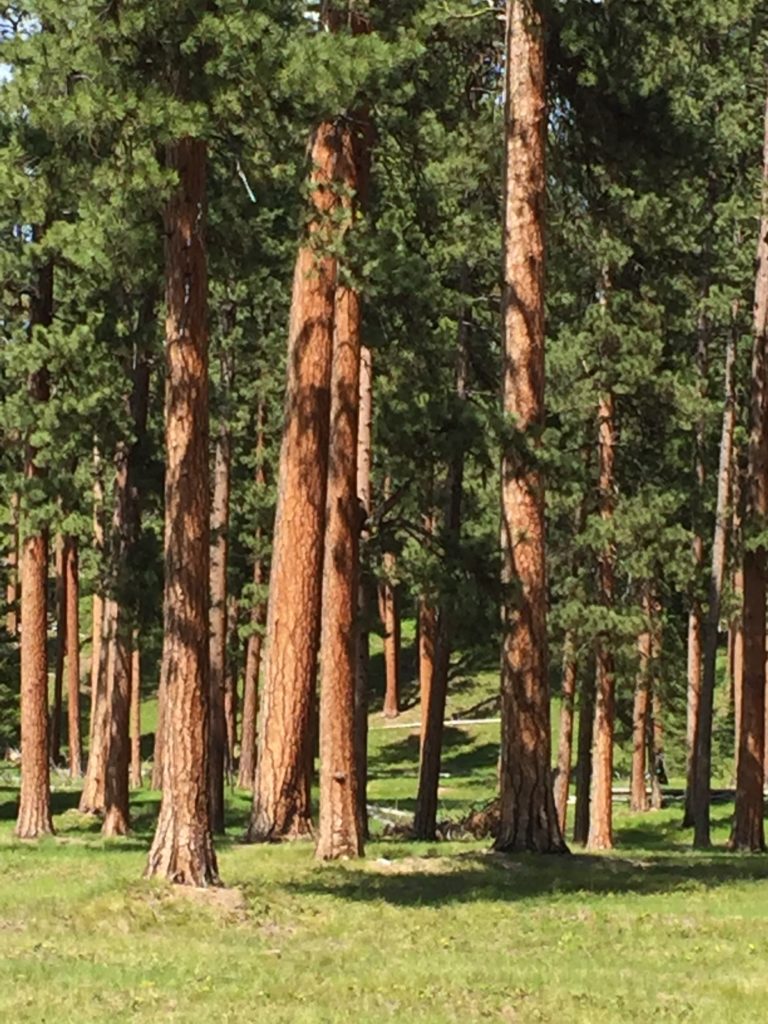
GOLD CREEK, Montana – Juxtaposition. Primm Meadow would be spectacular all on its own, as a park-like cathedral encompassing 112 acres of majestic ponderosa pines. But its location amidst what might otherwise be considered a “forest apocalypse” makes it all the more amazing.
Let me back up.
As we left Highway 200 near mile marker 9, along the Blackfoot River east of Missoula, and headed up Gold Creek Road, we passed through a young (20- to 50-year-old) and uneven-aged forest.

But shortly after we crossed over the saddle into Gold Creek, the landscape changed dramatically. The steep, rocky slopes of the canyon had been successively logged, burned by a ferocious wildfire, and salvage-logged. Now it was barren ground, accentuated by blackened stumps.
Although the fire had passed through about 15 years prior, the landscape still looked decimated. Small trees struggled to grow in the harsh conditions.
As we continued, however, replanted lodgepole and ponderosa pine began to reclaim the valley floor with a thick, young forest. These 20- to 30-foot-tall trees created a lush carpet over a topography once completely obscured by mature forest.
We parked at a gate near the main road, loaded our daypacks, and began our five-mile round-trip hike along a well-maintained gravel road on the south side of the creek, gently rising in elevation for the duration of the outward trip. I made a mental note that on our next visit, mountain bikes would be in order.

Our path was smooth and uneventful, surrounded by young trees and augmented by a soundtrack of the snowmelt-swollen creek and birdsongs defying the coolness of the morning. The day was misty with rain, and still early enough in the year that there were few wildflowers. A little short of the one-mile mark, we came to a second locked gate barring a sturdy wooden bridge across the West Fork of Gold Creek. If the lower gate is open when you visit, your hike will be halved, as there is adequate parking available at this upper gate.
Another mile along the road finally brought us a view of tall trees with vibrant red-orange trunks backed by dark forested mountains still capped with snow. That first glimpse of these mature trees, surrounded as they were by the young trees that barely came to their knees, emphasized how dramatically the landscape around us had changed. We were greeted by the shrill “kree-eee-ar” screams of a mating pair of red-tail hawks, surely a good sign.

**
Primm Meadow is a jewel shaped by both human and natural forces. Visited by Native Americans for thousands of years, then homesteaded in the 1890s (with a small portion farmed for hay and potatoes) and occupied into the late 1970s, the grove of 200- to 500-year-old pines was protected and managed in a way the surrounding landscape was not.
Native people valued the area and visited it seasonally, living under the tall trees, harvesting the sweet cambium layers of the larger pines, and then selectively burning the undergrowth to keep the forest productive for their annual use.

Homesteaders maintained the tradition of under-burns, or raked the needles, to keep the land cleared for their crops. This repeated use of controlled burns protected the grove when later wildfires swept through the area.
So special was this landscape that even the corporation that acquired the timber rights recognized its unique history and beauty and didn’t harvest its valuable trees. Eventually, through the efforts of private citizens and Five Valleys Land Trust, a conservation easement was negotiated with Plum Creek Timber Company, protecting Primm Meadow for visitors like you and me.
There are still remnants of previous occupants if you go exploring: trees stripped of large swaths of bark, rusted equipment, chunks of fencing, shallow irrigation ditches which meander across the grassy bench, and rocky foundation stones for the log cabin that once stood there. Interpretive signs tell the history of the Indian use and the two farming families who lived here.

Wildlife clearly enjoys the area. Woodpeckers leave their marks on the trunks of trees, polka-dotting the scorched bark. The standing snags provide homes for owls, woodpeckers, nuthatches, and pine squirrels. Occasional claw marks on the trunks testify that cougars and bears pass through from time to time.
But of course, the most dramatic elements of the area are the majestic trees themselves. Tall and stately, glowing red trunks and high crowns towering over a meadow lush with grasses and native plants, this stand is truly unique in juxtaposition to the commercially logged slopes all around it, something you will be reminded of as you retrace your steps back to the car.
It is well worth a visit if you find yourself in western Montana.
Shirley Atkins is a retired schoolteacher from Missoula, with a degree in environmental education.

What’s the elevation of this awesome place? Pretty sure it’s answered some questions I’ve had